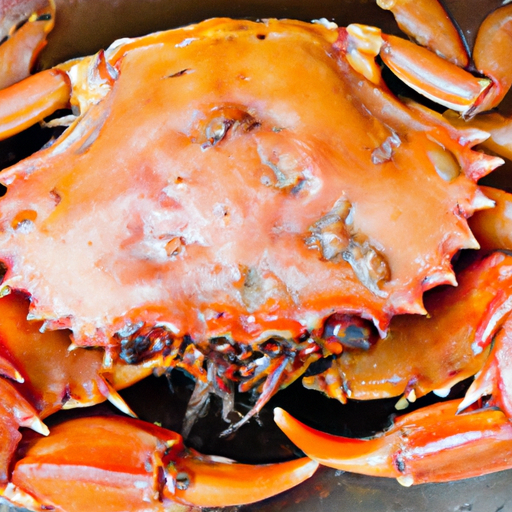The Wonderful World of Crab: A Decadent Delicacy
When it comes to seafood, few things can compare to the delectable taste and versatility of crab. Its tender meat, delicate flavor, and rich texture make it a favorite ingredient in many cuisines around the globe. Join me on a culinary journey as we explore the wonders of crab and its role in the world of cooking.
Perfectly Balanced Flavors
One of the most intriguing aspects of crab is its unique flavor, which can vary depending on the species and preparation method. Generally speaking, crab meat offers a sweet and briny taste that leaves a distinct impression on your palate. Its subtle buttery undertones add richness to the dish, making it an absolute treat for seafood enthusiasts.
Culinary Delight
Crab is no stranger to the culinary world, as it features prominently in a wide range of dishes. From hearty soups and stews to delicate appetizers and main courses, this versatile ingredient can be enjoyed in countless ways.
1. Crab Cakes: These golden-brown patties, typically made with a combination of crab meat, breadcrumbs, herbs, and spices, are a beloved classic. Served with a zesty sauce, they make for an irresistible appetizer or light meal.
2. Crab Bisque: Creamy, velvety, and infused with the essence of crab, this luxurious soup is a true indulgence. It showcases the delicate flavors of crab and is often elevated with a touch of sherry or brandy.
**3. Crab Linguine: Served over tender linguine pasta, this dish allows the natural sweetness of crab to shine. Lightly dressed in a buttery sauce with hints of garlic, lemon, and herbs, it creates a harmonious symphony of flavors.
4. Singapore-style Chili Crab: This iconic dish hails from Singapore and is an explosion of flavors. The succulent crab is drenched in a spicy, tangy tomato-based sauce that delivers a perfect balance of heat and sweetness.
These are just a few examples of the many delightful ways to enjoy crab. Its versatility allows it to star in both comforting, home-cooked meals and exquisite fine dining creations.
Nutritional Powerhouse
Not only is crab a delight for your taste buds, but it also packs a nutritional punch. It is an excellent source of lean protein, essential vitamins, and minerals. Crab meat is particularly rich in selenium, which plays a vital role in supporting a healthy immune system. It also provides a good amount of omega-3 fatty acids, known for their heart-healthy benefits.
Despite its relatively low calorie content, crab boasts an impressive array of nutrients. It’s a nutritious choice for those looking to maintain a balanced and healthy diet.
A Rich History
Crab has a storied history that dates back centuries. In many coastal communities, crabbing has long been part of the local culture and an important economic activity. Traditional fishing techniques, such as crab pots and traps, continue to be used today, preserving the heritage of this time-honored practice.
Crabs have also played a significant role in various cuisines throughout history. From the famous Chesapeake Bay blue crabs in the United States to the iconic Dungeness crabs of the Pacific Northwest, these crustaceans have brought joy to generations of seafood lovers.
Fun Fact: Molting Magic
Did you know that crabs undergo a unique process called molting? As they grow, crabs periodically shed their old shells and form new ones. During this vulnerable molting phase, the crabs are prized for their soft and tender meat, known as “soft-shell crab.” Soft-shell crab is a delicacy in many cuisines, often lightly battered and fried to perfection.
Deliciously Decadent: Crab is Calling!
Whether you savor it in a classic crab cake, slurp it from a creamy bisque, or embrace its delicate flavors in a simple pasta dish, crab is truly a remarkable ingredient. Its sweet, briny taste, versatility in cooking, and nutritional benefits make it a beloved delicacy worldwide.
So why wait? Treat yourself to the deliciousness of crab and explore the vast possibilities it offers in your kitchen. With crab, every dish has the potential to become a culinary masterpiece.
Facts about Crab:
Origin: Crabs are crustaceans that belong to the infraorder Brachyura. They can be found in oceans, freshwater lakes, rivers, and even on land. They have been in existence for millions of years and are believed to have originated during the Jurassic period.
Common Uses: Crab meat is highly regarded for its delicate flavor and tender texture. It is commonly used in various culinary dishes. Some popular examples include crab cakes, crab bisque, crab legs, and crab salads.
Nutritional Benefits: Crab is low in fat and calories while being rich in protein, vitamins, and minerals. It is a good source of omega-3 fatty acids, which are known for their heart-healthy benefits. Crab also has high levels of vitamins B12 and selenium, which play important roles in maintaining overall health.
Unique Properties: Crabs are known for their hard exoskeletons, which provide protection and support for their bodies. They have ten legs, with the front pair developed into claws. These claws are used for catching prey, defense, and communication. The size and shape of the crab can vary greatly depending on the species.
Historical Significance: Crabs have been an important part of human diets and culture throughout history. In Ancient Rome, crabs were considered a delicacy and were served at lavish banquets. In Chinese culture, the red color of cooked crab shells is associated with good luck and is often used in celebratory meals. Crabs are also used in seafood festivals and traditional coastal cuisines in many cultures.
Remember to always follow sustainable fishing practices and consume crab from reputable sources to support responsible seafood consumption.




Use the share button below if you liked it.
It makes me smile, when I see it.